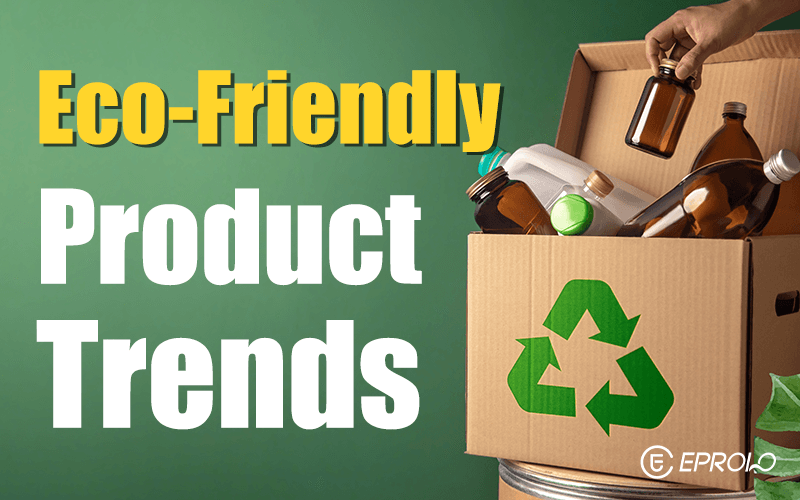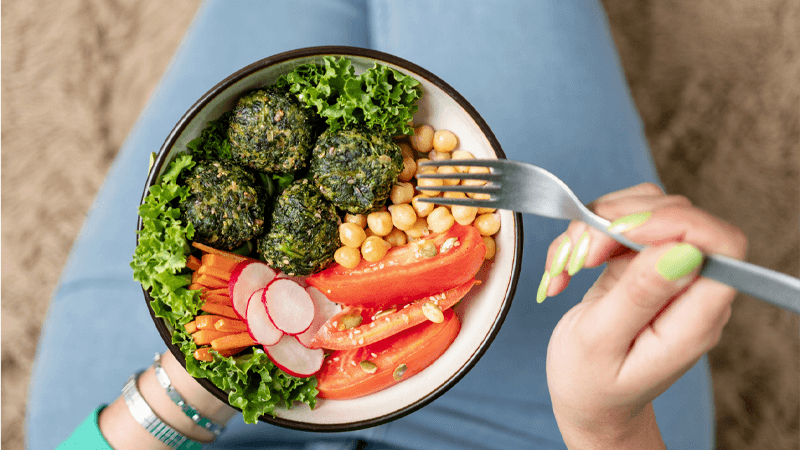As compras ecoconscientes estão impulsionando o movimento online este ano — e dropshippers inteligentes estão atentos. Sustentabilidade não é mais apenas um chavão. É uma alavanca comprovada para construir confiança na marca, aumentar a retenção de clientes e se antecipar a regulamentações mais rigorosas.
À medida que mais consumidores buscam produtos que correspondam aos seus valores, categorias ecológicas estão surgindo em todos os nichos, de cuidados pessoais a embalagens.
Este guia mostra o que é tendência, o que se encaixa no modelo de dropshipping e como posicionar esses produtos onde eles realmente converterão, esteja você vendendo no Shopify, Etsy ou TikTok Shop.

Visão geral da página:
1. Artigos domésticos reutilizáveis
2. Produtos orgânicos para cuidados pessoais
3. Alternativas de embalagens compostáveis
4. Alimentos e bebidas à base de plantas
5. Produtos de limpeza com baixo desperdício
6. Acessórios de Moda Sustentáveis
7. Dispositivos do dia a dia movidos a energia solar
8. Produtos ecológicos para animais de estimação
1. Artigos domésticos reutilizáveis
Produtos como embalagens alimentícias de cera de abelha, utensílios de bambu, tampas de silicone para tigelas e sacolas de tecido para produtos estão apresentando desempenho consistente em listas de palavras-chave em alta e conteúdos recomendados por influenciadores. Esses não são itens aspiracionais — são usados diariamente por famílias que buscam reduzir o desperdício descartável sem mudar drasticamente seus hábitos de vida.
- Bem adequados para as séries de conteúdo #cleaningtok e #zerowaste do TikTok.
- Comprados por pais jovens, defensores do baixo desperdício e públicos que gostam de presentes ecológicos.
- Baixa taxa de devolução devido à funcionalidade simples e baixa chance de defeito.
Melhores plataformas: Etsy, Shopify, TikTok Shop
Dica para dropshipping: Crie SKUs agrupados que incluam 3-5 itens relacionados para atingir o ponto ideal de valor médio do carrinho de $25, mantendo o peso do envio abaixo de 500g.
2. Produtos orgânicos para cuidados pessoais
Barras sólidas de shampoo, pastilhas de creme dental, máscaras faciais à base de argila e desodorantes de óleo essencial são cada vez mais preferidos por compradores que buscam rotinas de higiene seguras para a pele e sem plástico. A embalagem deles frequentemente serve também como parte da narrativa da marca — latinhas sem rótulo ou embalagens de papel reciclado reforçam a mensagem ecológica.
- Usuários postam ativamente sobre trocas sem plástico nas redes sociais.
- Tamanho compacto mantém os custos de fulfillment baixos.
- Alto potencial de assinatura devido ao ciclo diário de consumo.
Melhores plataformas: Shopify (para pedidos recorrentes), Etsy (para SKUs de presente)
Dica para dropshipping: Use descrições transparentes dos ingredientes e certificações de sustentabilidade no texto do produto. Ofereça amostras de um único item para incentivar testes com atrito mínimo.
3. Alternativas de embalagens compostáveis
Mais vendedores agora tratam a embalagem como parte da experiência do produto, especialmente quando se concentram em compradores altamente conscientes. Envelopes compostáveis, amendoins de enchimento à base de amido e fitas de papel ativadas por água demonstram forte engajamento no conteúdo de unboxing do TikTok e na narrativa da marca própria.
- Alto valor percebido em marcas DTC ecoconscientes.
- Comunica consistência ética desde a finalização da compra até a entrega.
- Frequentemente citado em avaliações positivas de produtos e tags de marcas.
Melhores plataformas: Shopify, Etsy
Dica para dropshipping: Adicione um selo de “Embalagem Sustentável” nas listas de produtos ou nos banners da loja. Mencione auditorias de terceiros ou padrões de compostabilidade (ex.: ASTM D6400).
4. Alimentos e bebidas à base de plantas
Caixas de lanches proteicos veganos, leites em pó à base de plantas, chás de superalimentos e biscoitos com infusão de sementes têm boa classificação nas tendências de busca do Pinterest e na categoria #plantbasedlife do TikTok. Esses itens atraem públicos preocupados com a saúde, que tomam decisões de compra com base tanto na ética alimentar quanto na embalagem minimalista.
- Alinha-se com múltiplas identidades de compradores (vegano, fitness, zero desperdício).
- Forte potencial de compra por impulso quando apresentados como kits de estilo de vida.
- Incentiva compras repetidas por meio de ciclos de consumo de vários dias.
Melhores plataformas: TikTok Shop, Shopify
Dica para dropshipping: Posicione kits pequenos e estáveis em prateleira como “amostras iniciais.” Foque na transparência dos ingredientes, vida útil e embalagens resseláveis no conteúdo visual.

5. Produtos de limpeza com baixo desperdício
Detergente sólido para louça, pastilhas de refil concentradas, escovas de bambu e panos de fibra vegetal oferecem valor diário visível, além de serem fotogênicos em páginas de produtos e vídeos de demonstração. Os consumidores desse segmento frequentemente buscam desempenho + minimalismo.
- O uso diário gera rápida familiaridade e confiança na marca.
- Reduz a desordem — especialmente importante em espaços pequenos.
- Popular entre influenciadores e seus públicos com “estética limpa”.
Melhores plataformas: TikTok, Shopify, Amazon
Dica para dropshipping: Calcule o uso médio mensal por produto e inclua na descrição. Mostre comparação de custo lado a lado com alternativas tradicionais.
6. Acessórios de Moda Sustentáveis
Os compradores estão recorrendo à cortiça, ao cânhamo, à juta e ao algodão reciclado para itens do dia a dia, como carteiras, bolsas tipo tiracolo, óculos de sol e brincos. Essas SKUs funcionam tanto como declarações éticas quanto como peças visuais centrais em conjuntos de fotos de influenciadores.
- Histórias sobre a origem dos materiais funcionam bem para legendas de blogs e redes sociais.
- Itens de moda menores enfrentam menos riscos de devolução por tamanho/ajuste.
- Baixo preço de entrada comparado ao vestuário; alto apelo visual por clique.
Melhores plataformas: Etsy, Shopify
Dica para dropshipping: Adicione a origem do material, informações sobre o artesão ou estatísticas de impacto aos carrosséis de imagens. Destaque "acabamento manual" ou "material de baixo carbono" sem exageros.
7. Dispositivos do dia a dia movidos a energia solar
Lanternas solares portáteis, luminárias de parede para áreas externas, bancos solares compactos e luminárias de destaque para jardim estão ganhando visibilidade tanto em feeds de camping quanto de decoração. Esses produtos ajudam os compradores a se sentirem autônomos e ecologicamente corretos, especialmente em casos de uso externo ou emergencial.
- Usabilidade independente em quedas de energia ou viagens fora da rede.
- Desempenho forte em buscas para “não precisa de eletricidade” ou “ideias para casas solares”.
- Ciclo de vida longo reduz arrependimento do comprador.
Melhores plataformas: Amazon, Shopify, TikTok
Dica para dropshipping: Use demos de iluminação antes/depois. Mencione classificação IP, saída de lúmen e vida útil do painel para compradores que fazem comparações.
8. Produtos ecológicos para animais de estimação
Sprays de higiene natural, sacos compostáveis para cocô, brinquedos de mastigar reciclados e petiscos sem grãos têm como público-alvo donos de animais de estimação que alinham seus cuidados com os animais a valores mais amplos de sustentabilidade. Esse segmento também responde bem a marcas "baseadas em histórias" que destacam as fontes dos ingredientes ou a ética da embalagem.
- O gasto médio com animais de estimação nas famílias aumentou pelo quarto ano.
- Os motivadores emocionais (cuidados com animais de estimação = cuidados com a família) fortalecem a retenção.
- A tag #ecopets do TikTok mostra métricas de engajamento crescentes.
Melhores plataformas: Etsy, TikTok, Amazon
Dica para dropshipping: Teste SKUs de pequenos lotes com formatos de caixa selecionados. Promova uma lógica de desconto em pacotes que se relacione aos ciclos de reposição.
Onde o EPROLO se encaixa neste movimento
A EPROLO oferece ferramentas para sourcing de produtos sustentáveis que funcionam diretamente dentro do modelo de dropshipping:
- Oferece categorias de produtos ecológicos de fornecedores verificados.
- Suporta opções de embalagens reutilizáveis e minimalistas.
- Permite sincronização com um clique para lojas Shopify e Etsy.
- Sem quantidade mínima de pedido, ideal para testar novos nichos.
Com a EPROLO, vendedores focados em sustentabilidade podem otimizar a gestão da loja enquanto atendem às expectativas crescentes dos consumidores. Desde o fulfillment de amostras até o suporte a embalagens verdes, a plataforma de dropshipping ajuda a preencher lacunas operacionais. Os vendedores podem testar a demanda, lançar mais rápido e construir uma identidade de loja baseada em propósito — não apenas conveniência.
Perguntas frequentes
Existem restrições de envio para produtos ecológicos?
Sim, alguns produtos ecológicos apresentam peculiaridades logísticas. Fique atento a itens como:
- Fórmulas à base de óleos essenciais.
- Soluções de limpeza derivadas de plantas.
- Materiais orgânicos com supervisão regulatória.
- Qualquer coisa que precise de controle de temperatura durante o transporte (pense em alimentos naturais sensíveis ao calor).
Como evito dores de cabeça com o envio?
Trabalhe com transportadoras que adquiram SKUs ecológicos. Use embalagens que protejam o produto e sua mensagem de sustentabilidade. Se possível, crie centros de distribuição locais para encurtar as distâncias de entrega. E sempre liste o produto corretamente — a classificação incorreta leva a atrasos ou paralisações.
Os produtos ecológicos são mais caros para enviar?
Um pouco. Pense em embalagens especiais ou manuseio térmico. Mas o aumento de custo costuma ser pequeno — e muitas vezes compensado por margens maiores ou fidelidade à marca.
Quais faixas de preço devo almejar?
Aqui está o ponto ideal por categoria:
- Cuidados pessoais: R$ 8 a R$ 25.
- Itens para casa: R$ 12 a R$ 35.
- Acessórios de moda: Espere uma margem de 20-50% sobre as alternativas convencionais.
- Produtos para o lar: R$ 25 a R$ 100+ dependendo do item.
De modo geral, um prêmio de 15-40% é típico. Apenas lembre-se: trata-se de comunicar valor, não de buscar o preço mais baixo.
Quais formatos de conteúdo realmente geram cliques?
Eco-friendly não significa chato. Use conteúdos que pareçam reais e úteis:
- Demonstrações de antes/depois que mostram como funciona bem.
- Histórias do BTS sobre terceirização ou produção ética.
- Análises baseadas em dados do impacto ambiental.
- Avaliações e UGC de clientes com consciência ecológica.
- Comparações lado a lado com produtos convencionais.
- Vídeos de estilo de vida mostrando o uso no mundo real.
- Infográficos com estatísticas, certificações e benefícios.
Conteúdo que educa e inspira vende. Pontos extras se for visual e autêntico.







